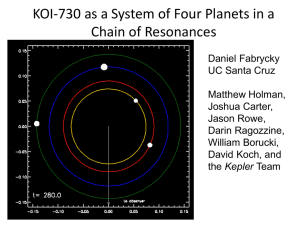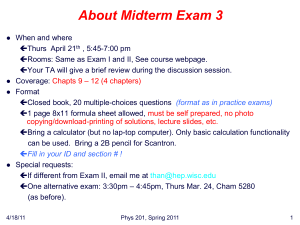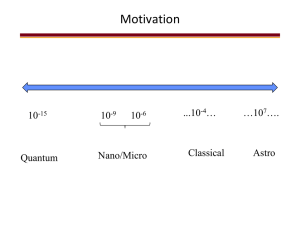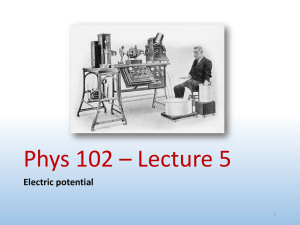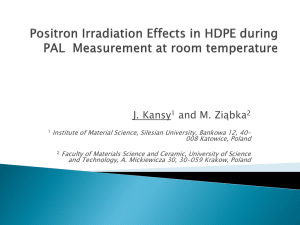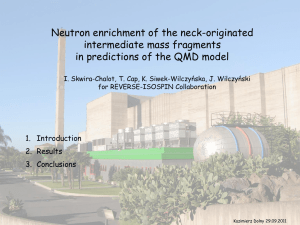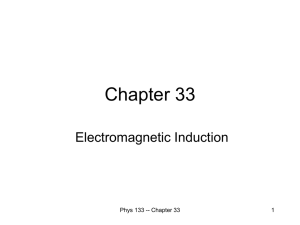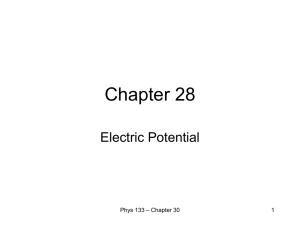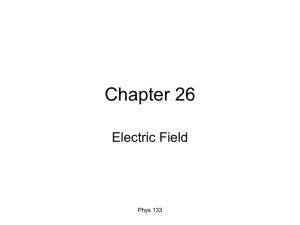Meson-exchanged models
advertisement
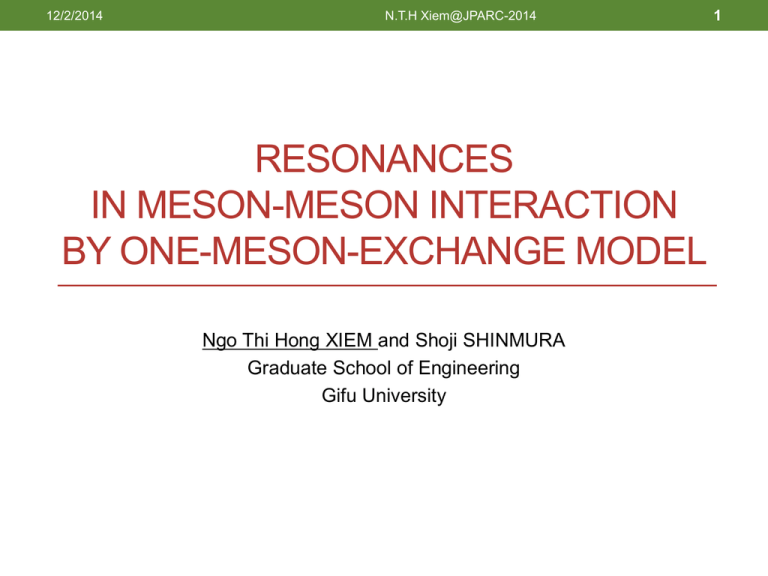
12/2/2014 N.T.H Xiem@JPARC-2014 RESONANCES IN MESON-MESON INTERACTION BY ONE-MESON-EXCHANGE MODEL Ngo Thi Hong XIEM and Shoji SHINMURA Graduate School of Engineering Gifu University 1 12/2/2014 N.T.H Xiem@JPARC-2014 Content Introduction 2. Formalization of the model 3. Results 4. Conclusion 1. 2 12/2/2014 N.T.H Xiem@JPARC-2014 Introduction 3 12/2/2014 N.T.H Xiem@JPARC-2014 Introduction • Meson-meson interaction is treated in • Quark Model • Chiral perturbation • J.A.Oller, E.Oset, Nucl.Phys A620, 438-456(1997). • J.A.Oller, E.Oset, Phys. Rev. D 59, 074001 (1999). • A.G.Nicola and J.R.Pelaez arXiv:help-ph/0109056v2 (2001). • LQCD • Silas R. Beane, Thomas C. Luu et al, Phys. Rev D 77, 094507 (2008). • Meson exchange model • D. Lohse et al, Nuc. Phys. A516, 513-548 (1990). • Meson-exchanged models keeps its validity as a suitable effective description of the h-h interactions in the low-energies region. • In meson-meson interaction 𝜋𝜋, 𝜋𝐾 scatterings have been investigated both in experiments and theories. • Construct a unified hadron-hadron potential model which appropriate for all BB, MB and MM interactions. 4 12/2/2014 N.T.H Xiem@JPARC-2014 Introduction • By 𝑆𝑈(3)-symmetric one-meson exchange mechanisms, we construct: • K𝐾 (𝑆 = −2) • 𝜋𝐾 − 𝜂 𝐾 (𝑆 = −1) • 𝜋𝜋 − 𝐾 𝐾 − 𝜂𝜋 − 𝜂𝜂 (𝑆 = 0) • 𝜋𝐾 − 𝜂𝐾 𝑆 = 1 • 𝐾𝐾 (𝑆 = 2) D. Lohse et al, Nuc. Phys. A516, 513-548 (1990). Only show the phase shift calculation! NO eta Prog. Theor. Exp. Phys. (2014) 023D04 doi: 10.1093/ptep/ptu001 5 12/2/2014 N.T.H Xiem@JPARC-2014 Formalization of the model 6 12/2/2014 7 N.T.H Xiem@JPARC-2014 Meson exchange potential • Feynman Diagram Exchange-meson 𝜌, 𝐾 ∗ , 𝜙, 𝜔, 𝑓2 , 𝜀1 , 𝑎0 , 𝜅 Bare mass. 𝑡-channel - 𝑠-channel Interaction Lagrangians for scalar, vector and tensor field Interaction Hamiltonian 𝑊 = − 𝐿𝑑 3 𝑥 Coupling constant Prog. Theor. Exp. Phys. (2014) 023D04 Form factors doi: 10.1093/ptep/ptu001 12/2/2014 8 N.T.H Xiem@JPARC-2014 Coupling constants • SU(3) Symmetric Lagrangians ℒ𝑝𝑝𝑠 = 𝑓𝑝𝑝𝑠 𝑚𝜋 𝑻𝒓 𝜕𝜇 𝑃𝜕𝜇 𝑃𝑆 ℒ𝑝𝑝𝑣 = 𝑔𝑝𝑝𝑣 𝑻𝒓 ( 𝜕𝜇 𝑃 𝑃 − 𝑃 𝜕𝜇 𝑃 )𝑉 2 ℒ𝑝𝑝𝑡 = 𝑔𝑝𝑝𝑡 𝑻𝒓 (𝜕𝜇 𝑃𝜕 𝜈 𝑃)𝑇𝜇𝜈 𝑚𝜋 𝑓𝑝𝑝𝑠 , 𝑔𝑝𝑝𝑣 , 𝑔𝑝𝑝𝑡 : coupling constants P is 3 × 3 matrix representation of the pseudo-scalar octet. S is 3 × 3 matrix representation of the scalar octet. V is 3 × 3 matrix representation of the vector octet. • 𝑃8 = 𝜋0 𝜂8 + 2 6 𝜋− 𝜋+ − 𝐾+ 𝜋0 𝜂8 + 2 6 𝐾0 𝐾0 𝜌0 𝜙 + 2 6 𝜌+ 𝐾 ∗+ 𝜌− 𝜌0 𝜙 − + 2 6 𝐾 ∗0 𝐾 ∗− 𝐾 ∗0 𝑎0 𝑓 + 0 2 6 𝑎+ 𝑃1 = 𝜂1 • 𝑉8 = − 𝑉1 = 𝜔 • 𝑆8 = 𝑎− 𝜅− 𝑆1 = 𝜎 2 𝜂 3 8 𝐾− − − ; 2 𝜙 3 𝜅+ 𝑎0 𝜙 + 2 6 𝜅0 ; 𝜅0 − 2 𝜙 3 ; 12/2/2014 N.T.H Xiem@JPARC-2014 Form Factors • Monopole Type • 𝑡-channel • 𝐹 (𝑡) (𝑞𝛼2 )= 2 Λ2 −𝑚𝛼 2) (Λ2 +𝑞𝛼 • 𝑠-channel • 𝐹 𝑠 (𝜔𝑝2 )= 2 Λ2 +𝑚𝛼 2) (Λ2 +𝜔𝑝 • Forth-order (𝑠-channel) • 𝐹4 (𝜔𝑝2 ) = 4 Λ4 +𝑚𝛼 4 Λ4 +𝜔𝑝 Λ : cut-off parameters 𝑞𝛼 : momentum 𝑚𝛼 : mass of exchanged mesons 𝜔𝛼 : total energy 9 12/2/2014 N.T.H Xiem@JPARC-2014 10 T-matrix and S-matrix • Using the quasi-potential V and solving the L-S Equation, we obtain the 𝑇- matrix : 𝑇 = 𝑉 + 𝑉𝐺𝑉 • S-matrix is given by 11 12 𝜂 𝑧 𝑒 2𝑖𝛿 (𝑧) 𝑖 1 − 𝜂 2 (𝑧)𝑒 2𝑖𝛿 (𝑧) 𝑆 𝑧 = 2𝑖𝛿 21 𝑧 2𝑖𝛿 22 (𝑧) 2 𝑖 1 − 𝜂 (𝑧)𝑒 𝜂 𝑧 𝑒 • 𝜂 𝑧 is the inelasticity; 𝛿 𝑖𝑗 the phase shift 12/2/2014 N.T.H Xiem@JPARC-2014 11 Resonances Poles with s-channel meson exchange • 𝑉 = 𝑉𝑡 + 𝑉𝑠 • 𝑉𝑠 contains s-channel diagrams • 𝑉𝑡 contains t-channel diagrams • 𝑉𝑠 𝑝′ , 𝑝 = 𝑖 𝛾𝑖 𝑝′ Δi P 𝛾𝑖 (𝑝) with bare mass and bare coupling constant • 𝑇 = 𝑇𝑡 + 𝑇𝑠 • 𝑇𝑠 = 𝛾 ∗ 𝑝′ Δ∗ P 𝛾 ∗ (p) • Δ∗ 𝑃 = Δ 𝑃 1−Δ 𝑃 Σ(p) : dressed propagator • Σ 𝑝 : self-energy • 𝛾 ∗ (𝑝) : dressed vertex Pure Dynamical Poles (without s-channel exchange) *This resonance renormalization follow: H.Polinder an Th. A. Rijken Phys. Rev. C 72, 065211 (2005) 12/2/2014 N.T.H Xiem@JPARC-2014 Results 12 12/2/2014 N.T.H Xiem@JPARC-2014 13 Parameters Monopole 𝑴𝟎 Mono. 𝜌 1126.66877 𝑔𝜋𝜋𝜌 0.50101 𝜀1 2112.07666 𝑔𝜋𝜋𝑓2 0.02843626 • All are free 𝐾∗ 1403.13526 𝑔𝜋𝜋𝜀1 0.01620557 𝜅 1522.01264 𝑔𝜋𝜋𝜅 0.191683 × 10−3 𝑓2 1367.63563 𝑔𝐾𝐾𝑎0 0.0408802 𝑎𝑜 1235.73076 Λ𝜋𝜋𝜌 2896.41242 𝜙 1150.23241 Λ𝜋𝐾𝐾∗ 2301.47525 Λ𝐾𝐾𝜌 3923.01907 Λ𝐾𝐾𝜔,𝜙 4520.8249 parameters. • Fitting with a large of experimental data is difficult, special for both well fitting of (𝐼 = 0, 𝐽 = 0) and (𝐼 = 1 , 𝐽 = 0). Mono. Λ𝜂𝐾𝐾∗ 864.0841 Λ𝜋𝜋𝜌;𝑠 2757.75065 Λ𝐾𝐾𝑎0 1233.61523 Λ𝜋𝜋𝑓2;𝑠 1481.43534 Λ𝐾𝐾𝑎0 2137.02377 Λ𝜋𝜋𝜀1 ;𝑠 1159.73371 Λ𝜋𝐾𝐾∗ ;𝑠 4061.81573 Λ𝜋𝐾𝜅;𝑠 3622.67379 • 24 parameters 2 12/2/2014 Phase shift results N.T.H Xiem@JPARC-2014 14 𝛿𝐽𝐼 ; 𝐼: isospin. 𝐽: total angular momentum 12/2/2014 Phase shift results N.T.H Xiem@JPARC-2014 15 𝛿𝐽𝐼 ; 𝐼: isospin. 𝐽: total angular momentum 12/2/2014 16 N.T.H Xiem@JPARC-2014 Resonances results "l-dd-f0" u 1:2:5 "l-dd-a0" u 1:2:5 18 16 14 12 10 8 6 4 2 0 -60 16 14 12 10 8 6 4 2 0 𝑎0 (980) -100 -90 -80 -70 -60 -50 -40 -30 -20 -101000 800 -50 850 -40 -30 900 -20 950 -10 𝑓0 (980) 960 980 940 920 900 "l-dd-f2" u 1:2:5 0 1000 "l-dd-rho" u 1:2:5 "l-dd-phi" u 1:2:5 35 14 12 10 𝜙(1020) 8 6 30 50 45 40 35 30 25 20 15 10 5 0 4 2 0 f2 (1270) 25 15 10 5 0 -300 1200 -250 -6 -5 -200 -4 -3 -2 -1 01040 1035 1030 1025 1020 1015 1010 𝜌(770) 20 -180 -160 1250 -140 -120 1300 -100 -80 1350 -60 1400 -40 -200 -150 -100 -50 900 850 800 750 700 650 600 12/2/2014 17 N.T.H Xiem@JPARC-2014 Resonances results "l-dd-kap7" u 1:2:5 "l-dd-kap14" u 1:2:5 𝜅(700) 120 45 40 35 30 25 20 15 10 5 0 100 𝜅(1430) 80 60 40 20 0 500 550 600 650 -100 -90 -80 1350 -70 -60 -50 1400 -40 -30 -20 700 -400 -350 -300 -250 -200 -150 -100 1300 750 "l-dd-sigm" u 1:2:5 -50 800 "l-dd-Kst" u 1:2:5 1450 -10 120 100 80 60 40 20 0 1500 0 50 45 40 35 30 25 20 15 10 5 0 𝐾 ∗ (892) 𝜎(500) -600 -550 -500 -450 300 -400 -55 -50 -45 -40 -35 -30 -25 -20 -15 980 960 940 920 900 880 860 840 350 -350 400 450 -300 -250 -200 600 500 550 12/2/2014 18 N.T.H Xiem@JPARC-2014 Summary Table of Pole Positions Exp. Data (PDG*) Monopole 𝑓0 (980) 990 ± 20 − 𝑖(40 to 100) 980 − 𝑖70 𝜎1 (500) 400 − 550 − 𝑖(200 − 350) 556 − 𝑖382 𝜎2 ------- 420 − 𝑖567 𝑎0 (980) 980 ± 20 − 𝑖(50 to 100) 860, −𝑖20 𝜌(770) 775.26 ± 0.25 − 𝑖(147.8 ± 0.9) 790 − 𝑖50 𝜙(1020) 1019.461 ± 0.019 − 𝑖(4.266 ± 0.031) 1020 − 𝑖2 𝑓2 (1270) 1275.1 ± 1.2 − 𝑖(184.2+4.0 −2.4 ) 1280 − 𝑖100 𝜅(1430) (1425 ± 50) − 𝑖(270 ± 80) 1440 − 𝑖50 𝜅(700) 682 ± 29 − 𝑖(547 ± 24) 640 − 𝑖200 𝐾 ∗ (892) 891.66 ± 0.26 − 𝑖(50.8 ± 0.9) [910, −20] ※𝑀 − 𝑖 *K.A. Olive et al. (Particle Data Group), Chin. Phys. C, 38, 090001 (2014). 𝚪 𝟐 12/2/2014 N.T.H Xiem@JPARC-2014 19 𝐼𝑚 𝑠 𝐼𝑚 𝑠 𝜎 500 and 𝜅(800) 𝑅𝑒 𝑠 𝑅𝑒 𝑠 *The experimental data of sigma resonances are from Muramatsu, Aitala,Ishida (97,00B,01), Alekseev (98,99), Troyan, Svec and Augustin. * The experimental data of kappa resonances are from Ablikim(06C,10E,11B), Descotes-g, Aitala, Bugg, Bonvicini, Link, Cawlfield, Zhou, Pelaez,Zheng and Ishida. 12/2/2014 20 N.T.H Xiem@JPARC-2014 Summary • Our calculations are well reproduce the phase shift, cross-section and pole position in the meson-meson interaction by the meson exchange model. • 𝜋𝜋 − 𝐾𝐾 𝑏𝑎𝑟 − 𝜋𝜂 − 𝜂𝜂 • 𝛿00 ; 𝛿01 ; 𝛿10 ; 𝛿11 ; 𝛿20 • 𝜎 600 , 𝑓0 980 , 𝜌 770 , 𝑎0 980 , 𝜙(1020) • 𝜋𝐾 − 𝜂𝐾 1 2 1 2 • 𝛿0 , 𝛿1 • 𝜅 700 , 𝜅 1430 , 𝐾 ∗ (982) • The shown results can prove the suitable effective of meson-exchange model on well-produce the interaction of mesons. • 𝜅 700 ; 𝜎(600) poles with broad width • FURTURE PLAN • Refine our model by reasonable bare mass fitting-parameter for 1 (𝛿00 ; 𝛿02 , 1 2 𝛿1 ) • Calculation with the Gaussian F.F • Solve the dynamical 3 body problems to study the existence and properties of the resonances in the hadronic system. 12/2/2014 N.T.H Xiem@JPARC-2014 THANK YOU FOR YOUR ATTENTION 21

